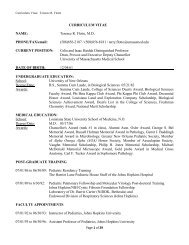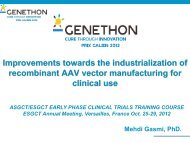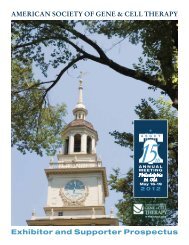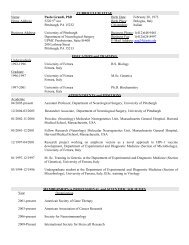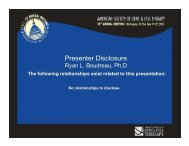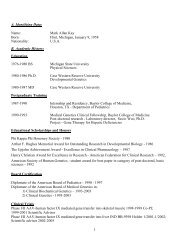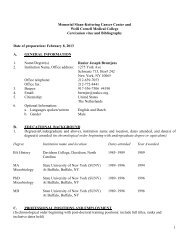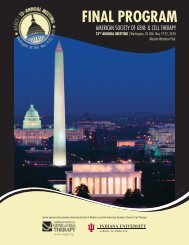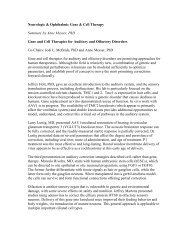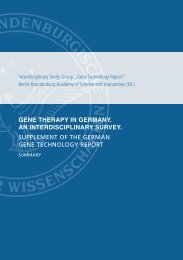Final Program - American Society of Gene & Cell Therapy
Final Program - American Society of Gene & Cell Therapy
Final Program - American Society of Gene & Cell Therapy
You also want an ePaper? Increase the reach of your titles
YUMPU automatically turns print PDFs into web optimized ePapers that Google loves.
<strong>Program</strong> Schedule, Wednesday, May 15, 2013<br />
Wednesday, May 15, 2013<br />
Scientific Symposium 104<br />
8:00 am - 10:00 am<br />
ROOM: 151 ABCG<br />
Novel Structural and Functional Assessment <strong>of</strong> the Respiratory Tract: Potential New Endpoints<br />
for <strong>Gene</strong> and <strong>Cell</strong> <strong>Therapy</strong><br />
CO-CHAIRS: David A. Dean, PhD and Christian Mueller, PhD<br />
SPEAKERS<br />
David W. Parsons, PhD<br />
Developments in Functional X-ray Imaging: ASL, MCT and “Pinpoint Spirometry”<br />
Driven by a desire to rapidly, accurately and reliably measure the effect <strong>of</strong> airway gene therapy treatments for Cystic Fibrosis<br />
in mice, we have been developing several novel analytical options for airways using synchrotron phase contrast X-ray. The high<br />
lux and coherence <strong>of</strong> synchrotron X-rays underlie our ability to visualize mouse airway-surface anatomy and activity in-vivo, to<br />
sub-micron resolution; ultra-fast imaging <strong>of</strong> dynamic lung movement in 4-dimensions to reveal regional airlows is also enabled.<br />
Importantly, all <strong>of</strong> these new approaches are designed to be non-invasive and allow airway health and function in intact animals<br />
to be examined. Alterations in the depth <strong>of</strong> the airway surface liquid (ASL) and altered Mucociliary Transit (MCT) are the earliest<br />
physiological effects <strong>of</strong> CFTR activity that can produce visible change in airway surface structure and function, and are key markers<br />
<strong>of</strong> CF airway health to be improved by an effective gene therapy. The core methods for the image capture, analysis, and presentation<br />
<strong>of</strong> both ASL and MCT markers are rapidly developing to provide new endpoint tools. The application <strong>of</strong> velocimetry techniques to<br />
synchrotron CT data has created a powerful new tool for regional lung health assessment (”pinpoint spirometry”) that is likely to be<br />
<strong>of</strong> particular value in animal models, and is also well suited to translation into a clinically-applicable system.<br />
Cecilia Lo, PhD<br />
Respiratory Motile Cilia Dysfunction in Congenital Heart Disease Patients and Contribution to Worse<br />
Postsurgical Outcomes<br />
Steven M. Rowe, MD<br />
Functional Anatomic Imaging <strong>of</strong> the CF Airway<br />
A critical barrier causing a roadblock in our understanding <strong>of</strong> CF pathogenesis is the lack <strong>of</strong> tools available for visualizing the<br />
important microstructural, functional, and biomechanical features <strong>of</strong> the respiratory mucosa and mucus in vivo. Recently, our<br />
laboratories have developed an innovative technology, termed 1-µm resolution optical coherence tomography (µOCT), which<br />
enables real-time cross-sectional microscopy <strong>of</strong> the functional epithelial surface <strong>of</strong> living airways and can be readily combined with<br />
measures <strong>of</strong> ion transport in vivo. With µOCT, we have been able to simultaneously and quantitatively monitor airway surface liquid<br />
(ASL) and periciliary layer (PCL) depths, ciliary beating, and mucociliary transport (MCT) in situ, while also measuring mucus<br />
viscosity by native particle tracking techniques without the use <strong>of</strong> contrast dyes, exogenous microparticles, or other manipulations.<br />
Key manifestations <strong>of</strong> the underlying CF defect can readily be observed, and an in vivo probe is currently under development. In<br />
addition to answering important questions regarding CF pathophysiology, this technology provides a clear path towards the use <strong>of</strong><br />
µOCT for monitoring functional responses to novel therapeutics.<br />
Maria P. Limberis, PhD<br />
Development <strong>of</strong> an AAV-based Prophylactic Vaccine against Pandemic Inluenza<br />
We will discuss the development <strong>of</strong> an effective prophylactic vaccine against inluenza. This vaccine is based on AAV9 vector and<br />
expresses a broadly neutralizing antibody against inluenza that protects relevant animal models against challenge with H5N1 and<br />
H1N1.<br />
34<br />
<strong>Final</strong> <strong>Program</strong> SALT LAKE CITY, UTAH May 15–18, 2013



